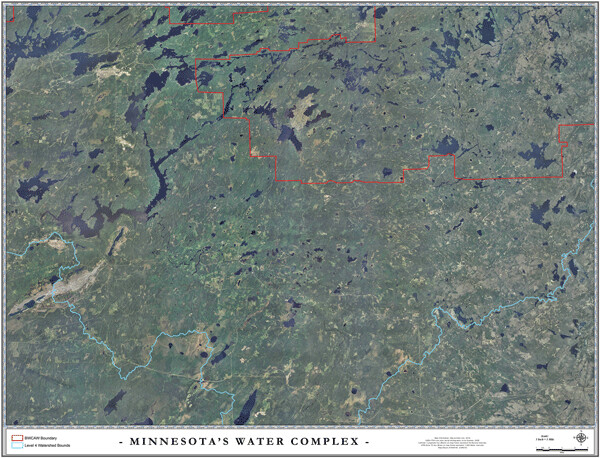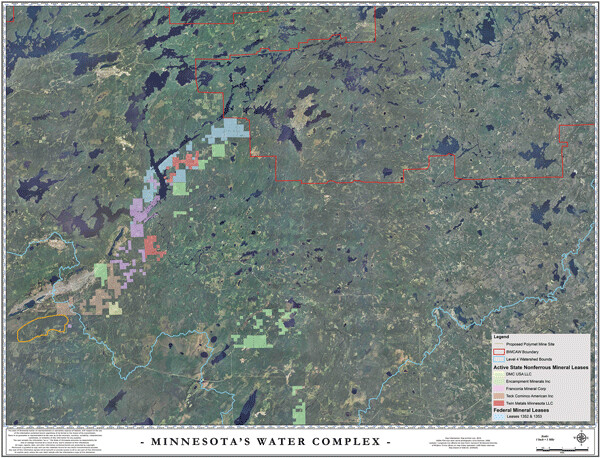Minnesota’s water war
In Minnesota, proposed sulfide mining is a war over water.


In Minnesota, proposed sulfide mining is a war over water.
Foreign mining giants Glencore Xstrata (majority owner of PolyMet) and Antofagasta (sole owner of Twin Metals) are planning to use multi-billion gallons of Minnesota’s waters to mine disseminated sulfide deposits containing less than 1% metals.
When sulfide mining promoters speak of the Duluth Complex, their rhetoric is only in the geological context of metal sulfides.
The Duluth Complex, a result of the Midcontinent Rift, is much more than metal sulfides. It is ancient magma, rock, and sediment. It is transformation by searing heat. The forces that formed the Duluth Complex also laid the foundation for Minnesota’s greatest treasure – its waters.
Glaciers scoured out basins – even as glaciers sculpted Lake Superior’s Rift-formed basin. Glacial melt water filled basins, creating lakes. The surface and groundwater that our lakes, rivers, streams, and wetlands now depend upon for healthy freshwater ecosystems developed into a fluid, life-giving legacy. Soils became richer, pine forests towered above, and wildlife was drawn to this incomparable place. Drawn to the waters that nourished it all.
The area encompassing the Duluth Complex is both a life-source and a buffer for the waters of northeastern Minnesota, and beyond. From Duluth to the Canadian border the watersheds of the Duluth Complex literally feed Minnesota’s – and the nation’s – priceless waters. It is northeastern Minnesota’s Water Complex.
Minnesota’s Water Complex and Duluth Complex inextricably linked
Minnesota’s Water Complex gives birth to the Rainy River Headwaters watershed, flowing north through the Boundary Waters Canoe Area Wilderness, Voyageurs National Park, and on into Canada.
Minnesota’s Water Complex contains headwaters of the St. Louis River watershed, flowing south to Lake Superior, the largest freshwater resource in the world by surface area.
Minnesota’s Water Complex contains Minnesota’s critical and strategic water reserves, one of the world’s largest freshwater deposits – arguably the largest – containing precious wetlands, streams, rivers, and lakes.
The Minnesota Pollution Control Agency calls the groundwater in the Duluth Complex a “sole-source aquifer;” it is the only drinking water aquifer in the Duluth Complex – in Minnesota’s Water Complex.
Planned assaults
Glencore Xstrata’s and Antofagasta’s proposed sulfide mines are forerunners of a vast sulfide mining industrial zone, massive open-pit mines coupled with the immensity of 99% mining wastes. Significant portions of Antofagasta’s mineral resources are the same above or below 1,000 feet; its underground mine would eventually become an open pit. A range of open-pit sulfide mines would stretch at least 30 miles through the Superior National Forest, destroying all surface resources, laying waste to Minnesota’s waters throughout our forested lake and river system.
Sulfide mining-polluted waters would flow through the St. Louis River watershed to Lake Superior and through the Rainy River Headwaters watershed to the BWCAW and Voyageurs National Park. It defies logic to argue about which mine would pollute which watershed. Taken together, they would undoubtedly pollute both.
At least eleven identified sulfide deposits in the Duluth Complex represent astronomical water usage and water pollution of both watersheds. Teck is silently waiting to make its move; its Mesaba Project is the largest sulfide deposit in the Duluth Complex. Add Rio TInto Kennecott’s Tamarack deposit – in the Mississippi River watershed – to the toxic mix.
PolyMet’s Final Environmental Impact Statement (EIS) stated that water treatment would be necessary “indefinitely,” meaning Minnesota’s waters would be polluted indefinitely by foreign mining companies that apparently expect us to clean up their mess, indefinitely. For doubters, it is easy to follow worldwide trails of corruption, lies, death and destruction attributed to Glencore Xstrata, Antofagasta, Teck, and Rio Tinto Kennecott.
Incredibly, our agencies refuse to do a total sulfide mining cumulative impact EIS with human health and ecological risk assessments to protect our waters and us.
Let alone a cost-benefit analysis. Minnesota would never be able to recover environmental and social costs once a denuded and useless landscape of toxic sulfide mines contaminated our water-rich region for perpetuity.
Economics of water
Antofagasta is expensively desalinating and using seawater in Chile for its mining operations. Sulfide mining in Minnesota is less about the value of low-grade metals, and more about the value of our freshwater.
Essentially free unlimited freshwater in Minnesota is equivalent to a winning Powerball, with only one winner, the mining industry. A water appropriation permit application costs $150, with annual water usage fees of $8 per million gallons (total cost capped according to the number of permits). Bottled water – at $1 per 16-ounce bottle – is $8 per gallon.
One acre-foot of water (an acre of water one foot deep) or 325,851 gallons bottled and sold would fetch $2.6 million. Start-up costs for a bottling operation run $100,000 to $200,000. I am no fan of bottled water. However, for comparison sake, northeastern Minnesota could bottle the equivalent of PolyMet’s water appropriations, 6 billion gallons (6,175 million gallons) per year; sell it within the Lake Superior basin of Minnesota under a catchy label – in glass bottles with deposit – and gross $49.3 billion ($49,270 million). $49.3 billion annually!
Nestle was under fire in California for using 705 million gallons of water per year for its bottled water operations. Yet, in Minnesota our lawmakers do not even blink at PolyMet’s 6,175 million gallons of water per year for PolyMet’s proposed sulfide mining operations; 5 billion, 470 million gallons of water more than Nestle was using. After the release of PolyMet’s initial Water Appropriations Consolidated Permit Application – which did not include Colby Lake make-up water – when asked if DNR Land and Minerals had a total water appropriations number to give the public, Land and Minerals had no response.
Then came PolyMet’s “Version 2” Water Appropriations Consolidated Permit Application; 5,725 million gallons annually was as close as the public could get to a total water appropriations number in the second, equally convoluted, permit application. On August 11, when the public comment period opened, the total annual water appropriations number had jumped to 6,175 million gallons, entitling PolyMet to annually pollute $6.2 billion gallons of our water.
Economics of mining
In 2012, iron mining’s total economic impact on Minnesota’s state and regional economy was approximately $3 billion annually (Minnesota Iron Mining). That figure does not include costs to the state for environmental cleanup, or the costs of environmental losses, or the millions of dollars of subsidies handed out to the taconite mining industry – an industry that claims reverse osmosis is not technically or economically feasible to use. It does not account for resultant public health costs, particularly the cost to northeastern Minnesota’s defenseless children.
In 2016, the Department of Commerce’s Bureau of Economic Analysis indicated that Minnesota has a $335 billion economy, with mining contributing $2.2 billion (less than one percent).
The 2017 Iron Range Resources and Rehabilitation Board’s annual operating budget is $32.6 million, funded by taconite production revenue in lieu of property taxes; funds often essentially rebated back to the industry.
Sulfide mining would contribute “tens of millions of dollars in local and state taxes annually.” (Mining Minnesota) In 2016, PolyMet claimed that it would generate $15 million annually in state and local tax revenues ($300 million over the 20-year life of the mine); and $515 million annually for St. Louis County in wages, benefits, and other spending ($10 billion over the 20-year life of the mine).
All rather paltry amounts compared to tens of billions of dollars generated annually if northeastern Minnesota bottled the equivalent of PolyMet’s water appropriations. Over twenty years, $49.3 billion annually would amount to $986 billion, just shy of a trillion dollars. $1 trillion! One mine’s water appropriations.
Instead, our agencies intend to pollute our waters for perpetuity.
The comparisons above are for those who are only able to assess the worth of our waters in monetary terms, for those who are not willing to put the health of Minnesota’s children first and foremost, who are willing to put everyone’s child in methyl mercury jeopardy – permanently – by permitting sulfide mining in Minnesota. Add arsenic, nickel, and manganese neurotoxin jeopardy.
Reverse osmosis will not save our waters
In 2005, Minnesota had the largest mining withdrawals of fresh surface-water in the nation, and ranked second for total mining withdrawals (groundwater and surface water).
In 2010, Minnesota was again at the top of the mining water-usage heap. (USGS). Add water usage for all proposed and projected water-polluting sulfide mining projects. PolyMet continues to tout reverse osmosis (RO) as the solution to pollution (along with dilution) even though the taconite industry in Minnesota says it cannot or will not use RO; and has gotten away with polluting our waters decade after decade.
The best description of RO that I have found came from a scientist, “Reverse osmosis isn't 'treatment.' It is only separation. RO sends contaminated water through a semi-permeable membrane at immense pressures, yielding 'permeate' (more or less clean water) and 'concentrate,' the concentrated glop consisting of the entire catalog of contaminants. The concentrate equals about 1/4 to 1/3 of the original volume of what’s fed into the system!” Or more.
Toxic concentrated contaminants collected during the RO process – including the spent filters – must be disposed of somewhere. Just how hazardous PolyMet’s toxic waste would be has never been precisely determined.
Which makes this the perfect time to bring up PolyMet’s 2012 news release, “PolyMet Reports Successful Water Treatment Pilot Plant,” which by the way did not actually use sulfide mining wastewater. The Pilot Plant used LTV taconite tailings leachate-contaminated water for its RO process; try wrapping your head around the irony of that one.
Or the irony of PolyMet’s Pilot Test disclaimer that stated: “Actual results may differ materially from those in the forward-looking statements … due to actual facts differing from the assumptions underlying its predictions.” (Italics added). PolyMet impunity.
There is no amount of Financial Assurance that can clean up what cannot be cleaned up. Sulfide mining is a war over Minnesota’s water. It is also a war on Minnesota’s children – whose health literally depends on protecting their waters.